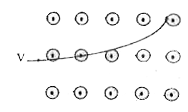Three charged particle with charge in ratio,1:1:2 and mass in ratio 1:2:4 enters in a region of uniform magnetic field. Calculate the ratio of radii of circular path described by three particles when inetic energy of all three particles is same.
The correct Answer is:1:√2:1
To solve the problem of finding the ratio of the radii of the circular paths described by three charged particles in a uniform magnetic field, we can follow these steps:
Step 1: Define the Charges and Masses
Let the charges of the three particles be:
- Charge of particle 1, q1=q
- Charge of particle 2, q2=q
- Charge of particle 3, q3=2q
Let the masses of the three particles be:
- Mass of particle 1, m1=m
- Mass of particle 2, m2=2m
- Mass of particle 3, m3=4m
Step 2: Use the Kinetic Energy Condition
We know that the kinetic energy K of a particle is given by:
K=12mv2
Since the kinetic energy of all three particles is the same, we can write:
12m1v21=12m2v22=12m3v23
This simplifies to:
m1v21=m2v22=m3v23
Step 3: Set Up the Ratios
Substituting the masses into the equation:
mv21=2mv22=4mv23
Dividing through by m (assuming m≠0):
v21=2v22=4v23
Step 4: Express Velocities in Terms of Each Other
From the above equations, we can express the velocities:
- From v21=2v22, we get v1=√2v2
- From v22=12v21, we get v2=1√2v1
- From v23=14v21, we get v3=12v1
Step 5: Calculate the Radii of the Circular Paths
The radius R of the circular path for a charged particle in a magnetic field is given by:
R=mvqB
Now, we can find the radii for each particle:
- For particle 1:
R1=mv1qB
- For particle 2:
R2=m2v2q2B=2m⋅1√2v1qB=2m⋅1√2v1qB=2mqB√2v1
- For particle 3:
R3=m3v3q3B=4m⋅12v12qB=4m2qBv1=2mqBv1
Step 6: Find the Ratios of the Radii
Now we can find the ratios:
R1:R2:R3=mv1qB:2mqB√2v1:2mqBv1
This simplifies to:
R1:R2:R3=1:2√2:2=1:√2:2
Final Answer
Thus, the ratio of the radii of the circular paths described by the three particles is:
R1:R2:R3=1:√2:2
Let the charges of the three particles be:
- Charge of particle 1, q1=q
- Charge of particle 2, q2=q
- Charge of particle 3, q3=2q
- Mass of particle 1, m1=m
- Mass of particle 2, m2=2m
- Mass of particle 3, m3=4m
We know that the kinetic energy K of a particle is given by:
K=12mv2
Since the kinetic energy of all three particles is the same, we can write:
12m1v21=12m2v22=12m3v23
This simplifies to:
m1v21=m2v22=m3v23
Substituting the masses into the equation:
mv21=2mv22=4mv23
Dividing through by m (assuming m≠0):
v21=2v22=4v23
From the above equations, we can express the velocities:
- From v21=2v22, we get v1=√2v2
- From v22=12v21, we get v2=1√2v1
- From v23=14v21, we get v3=12v1
The radius R of the circular path for a charged particle in a magnetic field is given by:
R=mvqB
Now, we can find the radii for each particle:
- For particle 1:
R1=mv1qB
- For particle 2:
R2=m2v2q2B=2m⋅1√2v1qB=2m⋅1√2v1qB=2mqB√2v1
- For particle 3:
R3=m3v3q3B=4m⋅12v12qB=4m2qBv1=2mqBv1
Now we can find the ratios:
R1:R2:R3=mv1qB:2mqB√2v1:2mqBv1
This simplifies to:
R1:R2:R3=1:2√2:2=1:√2:2
Thus, the ratio of the radii of the circular paths described by the three particles is:
R1:R2:R3=1:√2:2
Topper's Solved these Questions
- MOVING CHARGES AND MAGNETISMBOOK - MODERN PUBLICATIONCHAPTER - MOVING CHARGES AND MAGNETISMEXERCISE - Conceptual Questions
29 Videos
- MOVING CHARGES AND MAGNETISMBOOK - MODERN PUBLICATIONCHAPTER - MOVING CHARGES AND MAGNETISMEXERCISE - Tough & Tricky (PROBLEMS )
15 Videos
- MOVING CHARGES AND MAGNETISMBOOK - MODERN PUBLICATIONCHAPTER - MOVING CHARGES AND MAGNETISMEXERCISE - CHAPTER PRACTICE TEST
13 Videos
- MAGNETISM AND MATTERBOOK - MODERN PUBLICATIONCHAPTER - MAGNETISM AND MATTEREXERCISE - CHAPTER PRACTICE TEST FOR BOARD EXAMINATION
16 Videos
- NUCLEIBOOK - MODERN PUBLICATIONCHAPTER - NUCLEIEXERCISE - CHAPTER PRACTICE TEST FOR BOARD EXAMINATION
15 Videos
Similar Questions
A charged particle enters a region of uniform magnetic field at an angle of 85∘ to the magnetic line of force . The path of the particle is a circle .
View SolutionA proton and an alpha particle, both are moving with same initial velocity, perpendicular to uniform magnetic field of 1 T. Find the ratio of radii of circles described by the alpha particle and the proton.
View Solution
Knowledge Check
A proton and anα-particles enters in a uniform magnetic field with same velocity, then ratio of the radii of path describe by them
A0.042361111111111B0.043055555555556C0.084027777777778DNone of theseA proton, a deuteron and an α-particle with the same KE enter a region of uniform magnetic field, moving at right angles to B. What is the ratio of the radii of their circular paths ?
A1:√2:1B1:√2:√2C√2:1:1D√2:√2:1A proton, a deuteron and an α-particle with the same KE enter a region of uniform magnetic field, moving at right angles to B. What is the ratio of the radii of their circular paths ?
A1:√2:1B1:√2:√2C√2:1:1D√2:√2:1
A proton an an α−particle, moving with the same velocity, enter a uniform magnetic field, acting normal to the plane of their motion. The ratio of the radii of the circular paths descirbed by the proton and α-particle is
View SolutionIdentical charged particles are accelerated through the same potential difference, and then made to enter in a region of uniform magnetie field. If R1 and R2 , are the radii of a circular paths followed by particles then what will be the ratio of their masses.
View SolutionIf a charged particle enters perpendicular in the uniform magnetic field then
View SolutionA particle enters the region of a uniform magnetic field as shown in figure. The path of the particle inside the field is shown by dark line. The particle is :

View SolutionAn α particle and a proton having same momentum enter into a region of uniform magnetic field and move in circular paths. The ratio of the radii of curvature of their paths, RαRp in the field is
View Solution
